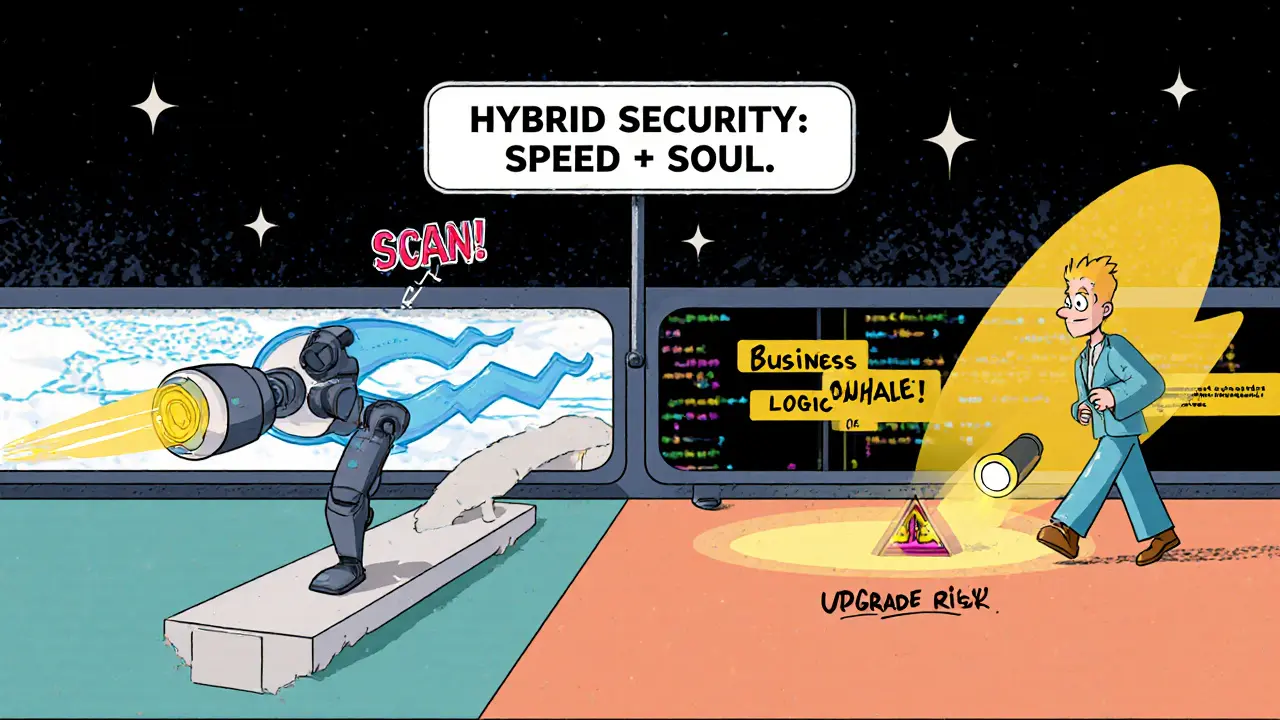Security Audit Cost-Benefit Calculator
Project Information
Audit Approach Options
Ideal for identifying known code vulnerabilities, runs continuously
Critical for business logic, governance, and economic vulnerabilities
Best of both worlds: automation for speed, humans for insight
Cost-Benefit Analysis
Results
Enter your project details above to see a cost-benefit analysis
When your blockchain smart contract holds millions in assets, how you audit it matters more than ever.
Imagine this: your DeFi protocol just got hacked. The attacker didn’t break through a firewall. They found a flaw in your contract’s logic-a tiny oversight in how funds are released after a vote. An automated scanner missed it. No alerts. No flags. Just silence until the money was gone. That’s the gap between automated and manual security auditing-and it’s not theoretical. It’s happened. And it’s happening again.
Blockchain systems don’t run on traditional IT infrastructure. They’re immutable, decentralized, and often open-source. One line of flawed code can cost millions. So when it comes to auditing, you can’t just pick one tool and call it done. You need to understand what each approach does well, where it fails, and how to use them together.
Automated auditing: Speed, scale, and the illusion of completeness
Automated security auditing tools scan your blockchain code like a spellchecker scans a document. They look for known vulnerabilities: reentrancy bugs, unchecked external calls, integer overflows, improper access controls. Tools like Slither, MythX, and Securify can scan thousands of lines of Solidity code in under a minute. They pull data from your smart contracts, check against a database of 500+ known exploit patterns, and spit out a report.
That’s fast. And cheap. A full automated audit for a medium-sized DeFi project costs between $3,000 and $8,000. It’s repeatable. Consistent. No human fatigue. No missed lines. And with cloud-native blockchains like Ethereum, Polygon, and Solana, these tools can run continuously-scanning every new deployment, every contract upgrade, every fork.
But here’s the catch: automated tools don’t understand context. They don’t know your business rules. They can’t tell if a function that allows anyone to withdraw funds after 30 days is a feature or a flaw. They miss logic errors that only a human would spot because they’ve seen it before in another protocol. In 2023, TechMagic found that automated tools missed 32% of business logic vulnerabilities in DeFi contracts-errors that led to over $400 million in losses across 12 major breaches.
And false positives? They’re everywhere. Automated scanners flag 15-30% of issues that aren’t real risks. That means your team spends hours chasing ghosts instead of fixing real problems. NIST’s 2008 report still holds: machines are great at finding what they’ve been taught to find. But they’re terrible at asking, “Why is this here?”
Manual auditing: The human edge in a machine world
Manual security auditing is slower. It’s expensive. A full manual audit by a certified team (CISSP, CISA) takes 40-60 hours and costs $15,000-$25,000. But it’s the only way to catch what machines can’t.
Human auditors don’t just read code. They think like attackers. They ask: Who can call this function? What happens if the price oracle fails? What if the governance token is concentrated in one wallet? They simulate real-world attacks-not just technical exploits, but social, economic, and governance ones.
In 2024, a major Ethereum-based lending protocol was audited manually. The automated tool gave it a clean bill of health. The human auditor found that the collateral liquidation threshold could be manipulated by a single whale holding 60% of the governance token. That’s not a code bug. That’s a design flaw. And it was worth $180 million in potential exposure.
Manual auditors also validate automated findings. They filter out false positives. They look at the bigger picture: How are keys stored? Who has access to upgrade contracts? Is the multisig wallet configured correctly? These aren’t lines of code. They’re processes. And processes don’t show up in a scan.
The downside? Human audits are inconsistent. One team might miss something another catches. That’s why Capterra users reported 34% of manual audits produced conflicting results. And they’re not continuous. Most teams do them quarterly-or worse, only before a mainnet launch. In blockchain, where attacks happen in hours, that’s too late.

Cost, time, and ROI: The numbers don’t lie
Let’s break down the real cost difference.
- Automated audit: $3,000-$8,000 per scan. Runs daily. Takes minutes. ROI in 6-9 months.
- Manual audit: $15,000-$25,000 per cycle. Done 2-4 times a year. Takes weeks. ROI? Hard to measure-but critical for compliance.
Secureframe’s 2024 survey showed companies using automated tools saved an average of 300 hours per year on compliance tasks. Median annual savings: $127,000. That’s not just time. That’s developer hours you can redirect to building, not fixing.
But here’s what no one talks about: the cost of not auditing properly. The average blockchain breach in 2024 cost $12.7 million. That’s 100 times the cost of a manual audit. Automated tools reduce risk. Manual audits reduce catastrophic risk.
And let’s talk about regulatory pressure. GDPR, HIPAA, SOC 2-83% of blockchain projects now cite compliance as their top reason for adopting automated auditing. But regulators don’t accept automation alone. They want proof of human oversight. That’s why the latest version of NIST SP 800-53 (coming December 2024) will explicitly allow automated monitoring to replace periodic manual audits-for technical controls only. For governance, access, and process controls? Still need a human.
The hybrid model: What the top 1% are doing
The best projects don’t choose between automated and manual. They combine them.
Here’s how a top-tier DeFi protocol does it in 2025:
- Automated tools scan every code commit on GitHub. If a vulnerability is found, the build fails. No exceptions.
- Every 30 days, a third-party firm runs a manual audit on the latest version-focusing on business logic, tokenomics, and governance.
- Scytale’s AI Agent (launched early 2024) analyzes audit reports, flags inconsistencies, and prioritizes findings by exploit likelihood.
- Before any major upgrade, a second manual audit is triggered-this time by a different team.
- All findings are logged in a public audit trail. Investors can see every step.
One financial services project on Ethereum cut its PCI DSS compliance prep time from 14 weeks to 3 weeks using this hybrid model. They kept manual audits only for their payment processing logic-the part where money actually moves. Everything else? Automated.
This isn’t just best practice. It’s becoming the industry standard. Gartner predicts that by 2027, 90% of blockchain security audits will be hybrid. Automated tools will handle 70-80% of the technical checks. Humans will focus on the rest: the hard problems, the edge cases, the logic that only a person can understand.

What happens if you only use one?
Using only automated tools? You’re running on autopilot. You’ll catch the obvious bugs. But you’ll miss the ones that matter. Sonrai Security documented 14 major breaches in 2023 where organizations trusted automated scans too much. One project ignored a warning about a non-standard ERC-20 transfer function. The scanner said “low risk.” The attacker exploited it to drain $89 million.
Using only manual audits? You’re playing catch-up. You audit quarterly. An attacker strikes in week two. You don’t know until your next audit cycle. That’s like locking your door once a month and hoping no one breaks in the rest of the time.
Blockchain moves faster than any other tech space. You can’t afford to be slow. But you also can’t afford to be blind.
How to start: A simple 3-step plan
If you’re building or managing a blockchain project in 2025, here’s your action plan:
- Start with automation. Pick one tool-Slither for Ethereum, Solana’s Anchor analyzer for Solana, or MythX for multi-chain. Integrate it into your CI/CD pipeline. Make it mandatory.
- Layer in manual audits. Hire a reputable firm (like CertiK, Trail of Bits, or OpenZeppelin) for your first mainnet launch. Then do one every 6 months-or after any major upgrade.
- Document everything. Publish your audit reports. Show your team’s responses. Prove you’re not just checking a box. You’re building trust.
Don’t wait for a breach to decide. The market is shifting. The tools are here. The standards are changing. And the cost of inaction is rising faster than the cost of adoption.
Final thought: Trust, but verify
Automated auditing is the engine. Manual auditing is the driver. One keeps you moving. The other keeps you alive.
In blockchain, security isn’t about choosing the best tool. It’s about building a system where tools and people work together. Where speed doesn’t sacrifice safety. Where scale doesn’t erase scrutiny.
The future of blockchain security isn’t automated or manual. It’s automated and manual. And if you’re not doing both, you’re not just behind-you’re exposed.
Can automated tools fully replace manual audits for blockchain projects?
No. Automated tools are excellent at finding known code vulnerabilities like reentrancy and overflow bugs, but they can’t understand business logic, governance structures, or economic incentives. A manual auditor can spot that a token distribution model allows one entity to control voting outcomes-something no scanner will flag. For high-value protocols, manual audits are still required for compliance and true risk assessment.
How often should I audit my blockchain smart contracts?
Automated scans should run continuously-on every code commit. Manual audits should happen at least once before mainnet launch, then every 6 months or after any major upgrade. If you’re handling large volumes of user funds or subject to regulations like SOC 2 or GDPR, quarterly manual audits are recommended. Never skip an audit after a protocol change.
What’s the biggest mistake teams make with security audits?
Assuming automated tools catch everything. Many teams run a scan, get a clean report, and assume they’re secure. That’s dangerous. Automated tools miss logic flaws, misconfigured permissions, and economic vulnerabilities. The most common cause of breaches isn’t a coding error-it’s a design flaw that only a human can spot.
Are manual audits worth the cost?
Yes-if you’re handling more than $1 million in user funds. The average blockchain breach in 2024 cost $12.7 million. A manual audit costs $15,000-$25,000. The ROI isn’t just financial-it’s reputational. Investors, users, and regulators trust projects that show they’ve done the hard work. A clean audit report is a marketing asset.
What tools are best for automated blockchain auditing in 2025?
For Ethereum and EVM chains, Slither and MythX are industry standards. For Solana, Anchor Analyzer is widely used. For multi-chain projects, Securify and OpenZeppelin Defender offer broad coverage. New AI-powered platforms like Scytale’s Scy AI Agent are reducing false positives by 45% and helping teams prioritize findings faster. Always choose tools that integrate with your CI/CD pipeline.

Andy Purvis
November 12, 2025 AT 03:43Elizabeth Stavitzke
November 12, 2025 AT 22:26Ainsley Ross
November 14, 2025 AT 21:40